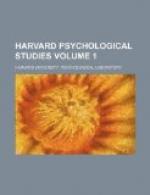Before the figures were placed in position, the subject was asked to close his eyes. The figures being placed, a few seconds’ warning was given, and at the word ‘look’ the subject opened his eyes and looked at the objects, closing his eyes again at the word ‘close.’ The time of exposure was five seconds. This time was divided as equally as possible between the two figures, which were simultaneously exposed, the observer glancing freely from one to the other as in the common observation on which our ideas of objects are founded. At the end of the exposure the subject sat with closed eyes and reported the several appearances and disappearances of the ideas or mental images of the objects just presented. The conditions required of him were that he should await passively the entry of the rival claimants on his attention, favoring neither and inhibiting neither; that is to say, he was to remit all volitional activity, save so far as was necessary to restrict his attention to the general field upon which the ideated objects might appear, and to note what occurred on the field. The period of introspection, which followed immediately the disappearance of such retinal images as remained, after the closing of the eyes to the external objects, lasted sixty seconds. The reports, like the signals, were given in a just audible tone. They were in such terms as ‘right—left,’ ‘small—large,’ ‘circle—star,’ terms the simplest that could be found, or such as seemed, in any given case, most naturally or automatically associated with the object, and therefore least likely to disturb the course of the observation. And each report was noted down by the experimenter at the instant it was given, with the time of each phase, in seconds, as indicated by a stop-watch under the experimenter’s eye.
It will be remarked that the attitude required of the observer was one which is not commonly taken. And it may be objected that the results of an attitude so unusual towards objects so ghostly and attenuated must be too delicate, or too complex, or influenced by too many alien suggestions, to be plumply set down in arabic numerals. The subjects, in fact, did at first find the attitude not easy to assume. A visual object may hold the attention by controlling the reflexes of the eye. But an ideational object has ordinarily no sure command of the conscious field save under the influence of a volitional idea or some strongly toned affectional state. But with a little practice the difficulty seemed to disappear. The subject became surer of his material, and the mental object gradually acquired the same sort of individuality as the visual object, though the impression it made might be less intense.
After a few preliminary experiments, figures were devised for the purpose of testing the effect of mere difference in the complexity of outline. That is to say, the members of every pair of objects were of the same uniform color-tone (Bradley’s neutral gray No. 2), presented the same extent of surface (approximately 42 sq. cm.), were exposed simultaneously for the same length of time (5 seconds), and were in contour usually of like general character save that the bounding line in the one was more interrupted and complex than in the other.




